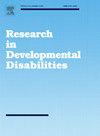Pain and sleep difficulties in young children with cerebral palsy does not vary by gross motor function, parent demographics, or parent expectations for rehabilitation therapy
IF 2.9
2区 医学
Q1 EDUCATION, SPECIAL
引用次数: 0
Abstract
Aim
The aims of the present study were to describe the prevalence of pain and sleep difficulties in children (2–8 years) with cerebral palsy (CP) and investigate the relationships between pain and sleep difficulties and gross motor function, parent demographics, and parent expectations for pain and sleep to improve with therapy services.
Methods and procedures
This cross-sectional study included parent reports of pain and sleep difficulties in children, demographic data, gross motor function, socioeconomic status (Hollingshead Four-Factor Index of Socioeconomic Status), and parent expectations of rehabilitation therapy services on pain and sleep (Pediatric Outcomes Data Collection Instrument).
Outcomes and results
Of the 97 participants, 47.4 % experienced pain in the week prior, 20.6 % the day of, and 33.0 % reported sleep difficulties. Pain in the week prior was significantly associated with sleep difficulties (p = 0.003). No significant relationships were found between pain and sleep difficulties and demographics, gross motor function, or parent income. Parent expectations regarding the impact of rehabilitation therapies on pain and sleep varied.
Conclusions and implications
Young children with CP demonstrate a high prevalence of pain and sleep difficulties. While pain is associated with sleep difficulties, gross motor function and parent demographics did not show associations. This underscores the need for comprehensive monitoring and rehabilitative treatments for pain and sleep difficulties in children with CP. Understanding the impact of rehabilitation therapies on pain and sleep in children with CP may help manage expectations for rehabilitation therapy services accurately.
年幼脑瘫儿童的疼痛和睡眠困难不会因大运动功能、父母人口统计或父母对康复治疗的期望而变化
目的本研究的目的是描述2-8岁脑瘫(CP)儿童疼痛和睡眠困难的患病率,探讨疼痛和睡眠困难与大运动功能、家长人口统计数据以及家长对疼痛和睡眠的期望通过治疗服务得到改善之间的关系。方法和程序本横断面研究包括儿童疼痛和睡眠困难的家长报告、人口统计数据、大运动功能、社会经济地位(Hollingshead四因素社会经济地位指数)和家长对疼痛和睡眠康复治疗服务的期望(儿科结局数据收集工具)。结果和结果在97名参与者中,47.4% %在前一周经历过疼痛,20.6% %在当天,33.0% %报告睡眠困难。前一周疼痛与睡眠困难显著相关(p = 0.003)。没有发现疼痛和睡眠困难与人口统计学、大运动功能或父母收入之间的显著关系。家长对康复治疗对疼痛和睡眠影响的期望各不相同。结论和意义年幼的CP患儿表现出较高的疼痛和睡眠困难患病率。虽然疼痛与睡眠困难有关,但大运动功能和父母的人口统计数据没有显示出关联。这强调了对CP儿童疼痛和睡眠困难进行全面监测和康复治疗的必要性。了解康复治疗对CP儿童疼痛和睡眠的影响可能有助于准确地管理对康复治疗服务的期望。
本文章由计算机程序翻译,如有差异,请以英文原文为准。
求助全文
约1分钟内获得全文
求助全文
来源期刊

Research in Developmental Disabilities
Multiple-
CiteScore
5.50
自引率
6.50%
发文量
178
期刊介绍:
Research In Developmental Disabilities is aimed at publishing original research of an interdisciplinary nature that has a direct bearing on the remediation of problems associated with developmental disabilities. Manuscripts will be solicited throughout the world. Articles will be primarily empirical studies, although an occasional position paper or review will be accepted. The aim of the journal will be to publish articles on all aspects of research with the developmentally disabled, with any methodologically sound approach being acceptable.
 求助内容:
求助内容: 应助结果提醒方式:
应助结果提醒方式:


